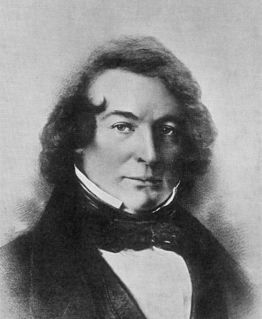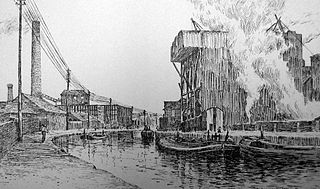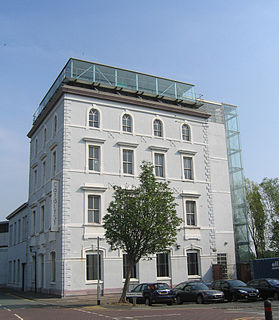Related Research Articles

St Helens and Runcorn Gap Railway was an early railway line owned by a company of the same name in Lancashire, England, which opened in 1833. It was later known as St Helens Railway. It ran originally from the town of St Helens to the area which would later develop into the town of Widnes. Branches were opened to Garston, Warrington and Rainford. The company was taken over by the London and North Western Railway in 1864. The line from St Helens to Widnes and the branch to Rainford are now closed, the latter terminating at the Pilkington Glass' Cowley Hill works siding near Gerard's Bridge, but part of the lines to Garston and to Warrington are still in operation.

James Muspratt was a British chemical manufacturer who was the first to make alkali by the Leblanc process on a large scale in the United Kingdom.
United Alkali Company Limited was a British chemical company formed in 1890, employing the Leblanc process to produce soda ash for the glass, textile, soap, and paper industries. It became one of the top four British chemical companies merged in 1926 with Brunner Mond, Nobel Explosives and British Dyestuffs Corporation to form Imperial Chemical Industries.

Hazlehurst & Sons was a company making soap and alkali in Runcorn, Cheshire, England in the 19th century and in the early years of the 20th century. The family was also largely responsible for the growth of Methodism in the town during the 19th century.

Widnes is an industrial town in the Borough of Halton, Cheshire, England, which at the 2011 census had a population of 61,464.

Ferdinand Hurter was a Swiss industrial chemist who settled in England. He also carried out research into photography.
Joseph Crosfield was a businessman who established a soap and chemical manufacturing business in Warrington, which was in the historic county of Lancashire and is now in the ceremonial county of Cheshire. This business was to become the firm of Joseph Crosfield and Sons.
Gossage is a family name of soapmakers and alkali manufacturers. Their company eventually became part of the Unilever group. During World War II, all soap brands were abolished by British government decree in 1942, in favour of a generic soap. When conditions returned to normal post war, the Gossage brand was not revived by Unilever though the company name is still registered for legal purposes. The online 'Times Index' shows meetings of the Gossage company board until the early 1960s.

William Gossage was a chemical manufacturer who established a soap making business in Widnes, Lancashire, England.
Tata Chemicals Europe is a UK-based chemicals company that is a subsidiary of Tata Chemicals Limited, itself a part of the India-based Tata Group. Its principal products are soda ash, sodium bicarbonate, calcium chloride and associated alkaline chemicals.

John Hutchinson was a chemist and industrialist who established the first chemical factory in Widnes, Lancashire, England. He moved from working in a chemical factory in St Helens and built his own chemical factory in 1847 in the Woodend area of Widnes near to Widnes Dock by the junction of the Sankey Canal and the River Mersey. In this factory he manufactured alkali by the Leblanc process.

Henry Deacon was a chemist and industrialist who established a chemical factory in Widnes, Lancashire, England.

Widnes is an industrial town in the Borough of Halton, Cheshire, England, on the north bank of the River Mersey where it narrows at Runcorn Gap. The town contains 24 buildings that are recorded in the National Heritage List for England as designated listed buildings. Of these, 5 are classified at Grade II*, and the rest are at Grade II; Widnes has no Grade I listed buildings. In the United Kingdom, the term "listed building" refers to a building or other structure officially designated as being of special architectural, historical, or cultural significance. Listed buildings are categorised in three grades: Grade I consists of buildings of outstanding architectural or historical interest; Grade II* includes particularly significant buildings of more than local interest; Grade II consists of buildings of special architectural or historical interest. Buildings in England are listed by the Secretary of State for Culture, Media and Sport on recommendations provided by English Heritage, which also determines the grading.
Edmund Knowles Muspratt was an English chemical industrialist.
Holbrook Gaskell II was a chemical industrialist in Widnes, Lancashire, England.

James Hargreaves was a British chemist and an inventor. He was born at Hoarstones in Fence, Lancashire, the eldest child of James Hargreaves, a schoolmaster at Slaithwaite near Marsden. His father moved to Sabden but as he found his salary to be insufficient the father became a druggist in 1844, later moving to Preston.

Charles Wigg was an English manufacturer of chemicals in Runcorn, Cheshire, England. After working as an export agent in Liverpool he joined with two managers of a Runcorn chemical factory to build what was initially known as the Old Quay Chemical Works, and later became Wigg Works. At first the works manufactured soap and alkali, but soon moved to extracting copper from pyrites ash, and later making bleaching powder and ferric oxide. During the later part of the 19th century it was one of the most successful businesses in Runcorn. Charles Wigg retired from the business shortly after it was taken over by the United Alkali Company and died eight years later. The site of the factory has been developed into a nature reserve called Wigg Island.

The Catalyst Science Discovery Centre and Museum is a science and technology museum in Widnes, Halton, North-West England. The centre has interactive exhibits, reconstructed historical scenes, an observatory, a live-science theatre and family workshops. It is next to Spike Island, a public park, located between the River Mersey and the Sankey Canal that has woodlands, wetlands, footpaths and industrial archaeological history.
Duncan McKechnie was a British chemical manufacturer and metal extractor. He was trained as a soap boiler in Glasgow and later moved to become a foreman at a soap and alkali factory in Runcorn, Cheshire. In 1869 he entered into partnership with two colleagues to run a new chemical factory in the town, but soon left to found his own company in St Helens. This company specialised in extracting and refining metals. It was sold to the United Alkali Company in 1891. After McKechnie's retirement his descendants continued to run factories bearing the name McKechnie into the 20th century.

The Statue of Ludwig Mond stands outside the entrance to Mond House in Brunner Mond Works, Winnington, Cheshire, England. Ludwig Mond was born in Germany but spent most of his working life in England. He moved to England in 1862 and joined the business of John Hutchinson in Widnes. Wishing to develop a better process for the production of alkali than the Leblanc process, he joined in partnership with John Brunner, who also worked for Hutchinson, to improve the ammonia-soda process, building a factory for this purpose at Winnington. In time the factory became the largest producer of soda in the world. Mond went on to work with other chemical processes, especially those involving nickel. He also became an art collector, bequeathing much of his collection to the nation. His statue was designed by Édouard Lantéri, and was unveiled by Brunner in 1913. It was moved in 1995 to stand next to the statue of Brunner in front of the offices of Brunner Mond in Winnington. The statue is recorded in the National Heritage List for England as a designated Grade II listed building.
References
Citations
- ↑ "Monumental Inscriptions | Over 25,000 Records | Toxteth Municipal Cemetery , Smithdown Road, Liverpool".
- 1 2 Hardie 1950 , pp. 78–79.
- ↑ Rintoul, Gordon (1984), Chemical Manufacture in Runcorn and Weston 1800 - 1930, archived from the original on 13 February 2012, retrieved 29 August 2013CS1 maint: bot: original URL status unknown (link)
- ↑ Diggle 1961 , p. 48
- ↑ Hardie 1950 , p. 226.
- ↑ Olin Mathieson Chemical Corporation, Harvard College , retrieved 24 September 2010
- ↑ Hardie 1950 , pp. 87, 149
Sources
- Diggle, Rev. G. E. (1961), A History of Widnes, Widnes: Corporation of Widnes, OCLC 450270
- Hardie, D. W. F. (1950), A History of the Chemical Industry of Widnes, London: Imperial Chemical Industries, OCLC 7503517